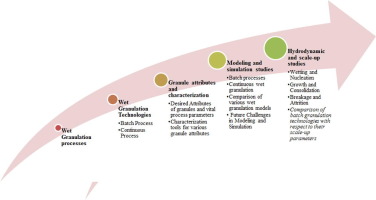Chemical Engineering Journal ( IF 13.3 ) Pub Date : 2017-07-16 , DOI: 10.1016/j.cej.2017.07.091 P. Suresh , I. Sreedhar , R. Vaidhiswaran , A. Venugopal

|
湿法制粒是非常重要的单元操作,可在许多行业中找到应用,主要是制药和化学行业。使用了分批和连续模式的各种制粒技术,即高剪切制粒机,流化床制粒机,双螺杆制粒机以及新型的造粒技术,例如泡沫造粒机,蒸汽造粒机,干法制粒机等。 ,表征工具,过程控制,建模和仿真,动力学和规模放大已根据发展趋势以及未来的挑战和前景进行了彻底的分析和讨论。强调了各种离线和在线特征化工具所发挥的关键作用及其应用。从PBM,DEM到混合模型的研究,基于CFD和ANN的模型就其性能和挑战进行了介绍。讨论了动力学研究,以了解制粒过程中各个步骤的速率和影响参数以及控制方式,以及所使用的模型。还从方法论的角度讨论了扩大规模,制粒的主要挑战,并提出了在适当控制工艺参数的情况下保持颗粒属性的效率。讨论了湿法制粒过程中使用的过程控制协议,以及不同颗粒和片剂属性与过程和设计参数之间的关系。为准研究人员列出了上述方面的未来挑战和前景。讨论了动力学研究,以了解制粒过程中各个步骤的速率和影响参数以及控制方式,以及所使用的模型。还从方法论的角度讨论了扩大规模,制粒的主要挑战,并提出了在适当控制工艺参数的情况下保持颗粒属性的效率。讨论了湿法制粒过程中使用的过程控制协议,以及不同颗粒和片剂属性与过程和设计参数之间的关系。为准研究人员列出了上述方面的未来挑战和前景。讨论了动力学研究,以了解制粒过程中各个步骤的速率和影响参数以及控制方式,以及所使用的模型。还从方法论的角度讨论了扩大规模,制粒的主要挑战,并提出了在适当控制工艺参数的情况下保持颗粒属性的效率。讨论了湿法制粒过程中使用的过程控制协议,以及不同颗粒和片剂属性与过程和设计参数之间的关系。为准研究人员列出了上述方面的未来挑战和前景。还讨论了制粒的主要挑战,包括方法学和在适当控制工艺参数的情况下保持颗粒属性的效率。讨论了湿法制粒过程中使用的过程控制协议,以及不同颗粒和片剂属性与过程和设计参数之间的关系。为准研究人员列出了上述方面的未来挑战和前景。还讨论了制粒的主要挑战,包括方法学和在适当控制工艺参数的情况下保持颗粒属性的效率。讨论了湿法制粒过程中使用的过程控制协议,以及不同颗粒和片剂属性与过程和设计参数之间的关系。为准研究人员列出了上述方面的未来挑战和前景。

"点击查看英文标题和摘要"


















































 京公网安备 11010802027423号
京公网安备 11010802027423号